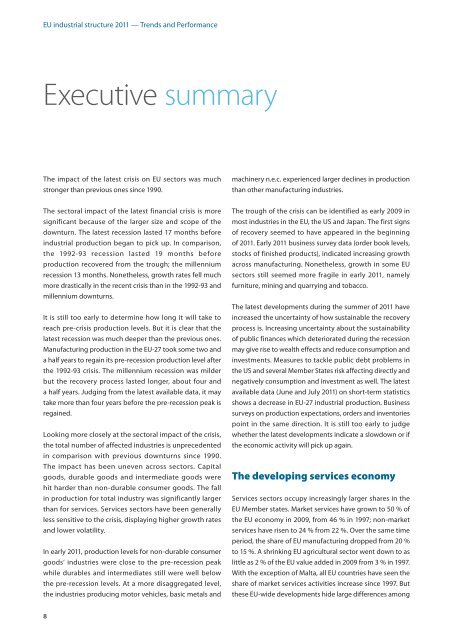EU industrial structure - EU Bookshop - Europa
EU industrial structure - EU Bookshop - Europa
EU industrial structure - EU Bookshop - Europa
Create successful ePaper yourself
Turn your PDF publications into a flip-book with our unique Google optimized e-Paper software.
<strong>EU</strong> <strong>industrial</strong> <strong>structure</strong> 2011 — Trends and Performance<br />
Executive summary<br />
The impact of the latest crisis on <strong>EU</strong> sectors was much<br />
stronger than previous ones since 1990.<br />
The sectoral impact of the latest financial crisis is more<br />
significant because of the larger size and scope of the<br />
downturn. The latest recession lasted 17 months before<br />
<strong>industrial</strong> production began to pick up. In comparison,<br />
the 1992‑93 recession lasted 19 months before<br />
production recovered from the trough; the millennium<br />
recession 13 months. Nonetheless, growth rates fell much<br />
more drastically in the recent crisis than in the 1992‑93 and<br />
millennium downturns.<br />
It is still too early to determine how long it will take to<br />
reach pre‑crisis production levels. But it is clear that the<br />
latest recession was much deeper than the previous ones.<br />
Manufacturing production in the <strong>EU</strong>‑27 took some two and<br />
a half years to regain its pre‑recession production level after<br />
the 1992‑93 crisis. The millennium recession was milder<br />
but the recovery process lasted longer, about four and<br />
a half years. Judging from the latest available data, it may<br />
take more than four years before the pre‑recession peak is<br />
regained.<br />
Looking more closely at the sectoral impact of the crisis,<br />
the total number of affected industries is unprecedented<br />
in comparison with previous downturns since 1990.<br />
The impact has been uneven across sectors. Capital<br />
goods, durable goods and intermediate goods were<br />
hit harder than non‑durable consumer goods. The fall<br />
in production for total industry was significantly larger<br />
than for services. Services sectors have been generally<br />
less sensitive to the crisis, displaying higher growth rates<br />
and lower volatility.<br />
In early 2011, production levels for non‑durable consumer<br />
goods’ industries were close to the pre‑recession peak<br />
while durables and intermediates still were well below<br />
the pre‑recession levels. At a more disaggregated level,<br />
the industries producing motor vehicles, basic metals and<br />
8<br />
machinery n.e.c. experienced larger declines in production<br />
than other manufacturing industries.<br />
The trough of the crisis can be identified as early 2009 in<br />
most industries in the <strong>EU</strong>, the US and Japan. The first signs<br />
of recovery seemed to have appeared in the beginning<br />
of 2011. Early 2011 business survey data (order book levels,<br />
stocks of finished products), indicated increasing growth<br />
across manufacturing. Nonetheless, growth in some <strong>EU</strong><br />
sectors still seemed more fragile in early 2011, namely<br />
furniture, mining and quarrying and tobacco.<br />
The latest developments during the summer of 2011 have<br />
increased the uncertainty of how sustainable the recovery<br />
process is. Increasing uncertainty about the sustainability<br />
of public finances which deteriorated during the recession<br />
may give rise to wealth effects and reduce consumption and<br />
investments. Measures to tackle public debt problems in<br />
the US and several Member States risk affecting directly and<br />
negatively consumption and investment as well. The latest<br />
available data (June and July 2011) on short‑term statistics<br />
shows a decrease in <strong>EU</strong>‑27 <strong>industrial</strong> production. Business<br />
surveys on production expectations, orders and inventories<br />
point in the same direction. It is still too early to judge<br />
whether the latest developments indicate a slowdown or if<br />
the economic activity will pick up again.<br />
The developing services economy<br />
Services sectors occupy increasingly larger shares in the<br />
<strong>EU</strong> Member states. Market services have grown to 50 % of<br />
the <strong>EU</strong> economy in 2009, from 46 % in 1997; non‑market<br />
services have risen to 24 % from 22 %. Over the same time<br />
period, the share of <strong>EU</strong> manufacturing dropped from 20 %<br />
to 15 %. A shrinking <strong>EU</strong> agricultural sector went down to as<br />
little as 2 % of the <strong>EU</strong> value added in 2009 from 3 % in 1997.<br />
With the exception of Malta, all <strong>EU</strong> countries have seen the<br />
share of market services activities increase since 1997. But<br />
these <strong>EU</strong>‑wide developments hide large differences among
















